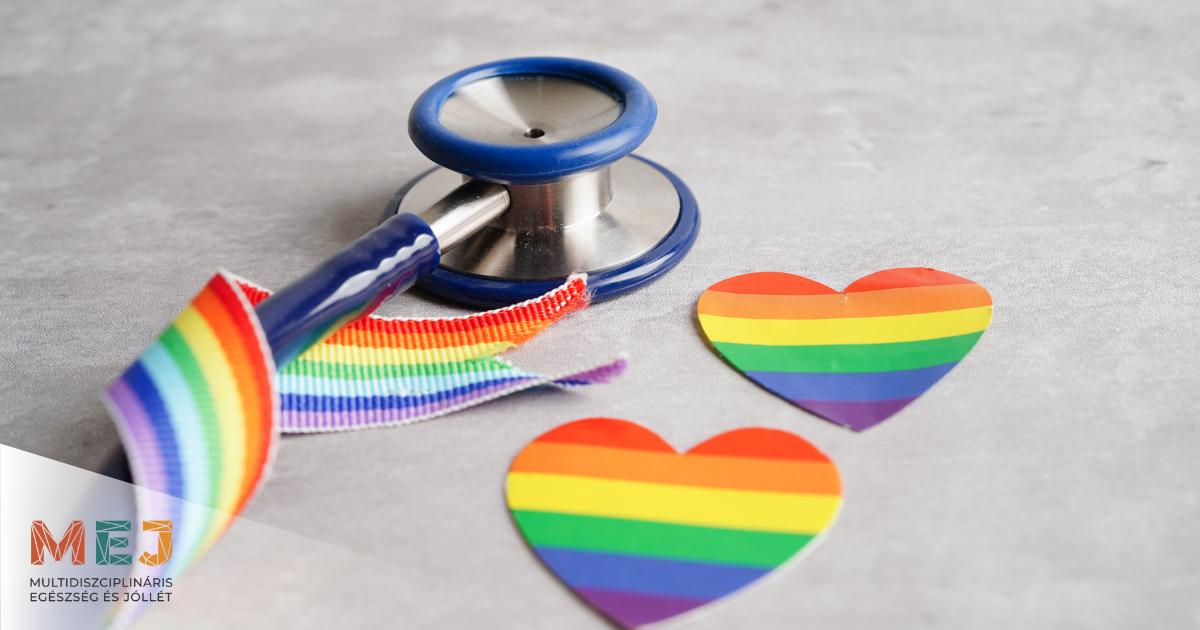A nemi kisebbségekhez tartozó személyek orvosi ellátásának aktuális kérdései
Absztrakt
Az elmúlt 40 évben a nemi kisebbségek speciális orvosi ellátásához szükséges kutatások elterjedése és a publikációk folyamatos növekedése figyelhető meg a külföldi orvosi adatbázisokban. A nemi vonzalom és identitás sajátosságai nagyban befolyásolják a helyes diagnózis felállítását, a szükséges kezelések és szűrések meghatározását, valamint a magas öngyilkossági veszélyeztetettség miatt a prevenciós beavatkozási pontok körét is. Az orvosi adatbázisokon kívül orvosszakmai szervezetek és oktatási-kutatási hátterű klinikai intézmények is számos bevált gyakorlatról és irányelvről adnak tájékoztatást. A szükséges ismeretek bővítésén túl előremutató lehet a nem tudatos előítéletek csökkentése és az orvos-beteg kommunikáció elmélyítése.
Hivatkozások
Organisation for Economic Co-operation and Development. Society at a glance 2019: OECD social indicators. OECD Publishing, Paris, 2019; pp. 9–10.
Raifman J, Moscoe E, Austin SB, et al. Difference-in-differences analysis of the association between state same-sex marriage policies and adolescent suicide attempts. JAMA Pediatr. 2017; 171: 350–356.
Frimpong EY, Rowan GA, Williams D, et al. Health disparities, inpatient stays, and emergency room visits among lesbian, gay, and bisexual people: evidence from a mental health system. Psychiatr Serv. 2020; 71: 128–135.
Urwin S, Whittaker W. Inequalities in family practitioner use by sexual orientation: evidence from the English General Practice Patient Survey. BMJ Open 2016; 6: e011633.
Hatzenbuehler ML, Pachankis JE. Stigma and minority stress as social determinants of health among lesbian, gay, bisexual, and transgender youth: research evidence and clinical implications. Pediatr Clin North Am. 2016; 63: 985–997.
Makadon HJ, Mayer KH, Potter J, et al. The Fenway guide to lesbian, gay, bisexual, and transgender health. 2nd edn. American College of Physicians, Philadelphia, PA, 2015.
Frankowski BL, Committee on Adolescence. Sexual orientation and adolescents. Pediatrics 2004; 113: 1827–1832.
Mustanski B. Ethical and regulatory issues with conducting sexuality research with LGBT adolescents: a call to action for a scientifically informed approach. Arch Sex Behav. 2011; 40: 673–686.
Welch MJ, Lally R, Miller JE, et al. The ethics and regulatory landscape of including vulnerable populations in pragmatic clinical trials. Clin Trials 2015; 12: 503–510.
Blondeel K, Say L, Chou D, et al. Evidence and knowledge gaps on the disease burden in sexual and gender minorities: a review of systematic reviews. Int J Equity Health 2016; 15: 16.
Jowett A. Chronic illness in non-heterosexual contexts: towards a critical LGBTQ health psychology. Aston University, 2011; pp. 69–70.
Daniel H, Butkus R, Lesbian, gay, bisexual, and transgender health disparities. Executive summary of a policy position paper from the American College of Physicians. Ann Intern Med. 2015; 163: 135–137 + Appendix.
Mayo Clinic. Health issues for gay men and men who have sex with men. Health issues for lesbians and women who have sex with women. Rochester, NY, 2017. Available from: https://www.mayoclinic.org/healthy-lifestyle/adult-health/in-depth/health-issues-for-gay-men/art-20047107 and https://www.mayoclinic.org/healthy-lifestyle/adult-health/in-depth/health- issues-for-lesbians/art-20047202 [assessed: August 15, 2020].
American College of Physicians. Sample New Patient Intake Form. Appendix B. In: Makadon HJ, et al. (eds.) The Fenway guide to lesbian, gay, bisexual, and transgender health. Philadelphia, PA, 2007; pp. 487–502. Available from: http://www.east-baypride.com/sample-new-patient-intake-form.pdf [accessed: August 16, 2020].
Lim FA, Brown DV Jr, Justin Kim SM. Addressing health care disparities in the lesbian, gay, bisexual, and transgender population: a review of best practices. Am J Nurs. 2014; 114: 24–34.
Paul JP. The bisexual identity: an idea without social recognition. J Homosex. 1983–1984 Winter–Spring; 9(2–3): 45–63.
Copen CE, Chandra A, Febo-Vazquez I. Sexual behavior, sexual attraction, and sexual orientation among adults aged 18–44 in the United States: data from the 2011–2013 National Survey of Family Growth. Natl Health Stat Report 2016; 88: 1–14.
Barker MJ, Richards C, Jones R, et al. The bisexuality report: bisexual inclusion in LGBT equality and diversity. Open University, Milton Keynes, 2012.
San Francisco Human Rights Commission. Bisexual invisibility. Impacts and recommendations. San Francisco Human Rights Commission LGBT Advisory Committee, San Francisco, CA, 2010.
Pompili M, Lester D, Forte A, et al. Bisexuality and suicide: a systematic review of the current literature. J Sex Med. 2014; 11: 1903–1913
King M, McKeown E. Mental health and social wellbeing of gay men, lesbians and bisexuals in England and Wales. Mind, London, 2003.
Barker MJ, Bowes-Catton H, Iantaffi A, et al. British bisexuality: a snapshot of bisexual identitites in the UK. J Bisex. 2008; 8: 141–162.
Miller M, André A, Ebin J, et al. Bisexual health: an introduction and model practices for HIV/STI prevention programming. National Gay and Lesbian Task Force Policy Institute, Washington, DC, 2007.
Hickson F, Bourne A, Weatherburn P, et al. Tactical dangers: findings from the United Kingdom Gay Men’s Sex survey 2008. Sigma Research, London, 2010.
Goodenow C, Netherland J, Szalacha L. AIDS-related risk among adolescent males who have sex with males, females or both: evidence from a statewide survey. Am J Public Health 2002; 92: 203–210.
Fethers K, Marks C, Mindel A, et al. Sexually transmitted infections and risk behaviours in women who have sex with women. Sex Transm Infect. 2000; 76: 345–349.
Ekstrand ML, Coates TJ, Guydish JR, et al. Are bisexually identified men in San Francisco a common vector for spreading HIV infection to women? Am J Public Health 1994; 84: 915–919.
Kahn JG, Gurvey J, Pollack LM, et al. How many HIV infections cross the bisexual bridge? An estimate from the United States. AIDS 1997; 11: 1031–1037.
Rafferty J, Committee on Psychosocial Aspects of Child and Family Health, Committee on Adolescence, Section on Lesbian, Gay, Bisexual and Transgender Health and Wellness. Ensuring comprehensive care and support for transgender and gender-diverse children and adolescents. Pediatrics 2018; 142: e20182162.
Nussbaum AM. DSM-5 diagnosis book. [A DSM-5 diagnosztikai vizsgálat zsebkönyve.] Oriold és Társai, Budapest, 2013. [Hungarian]
ICD-11 for mortality and morbidity statistics. Version: 04/2019. Available from: https://www.wpath.org/publications/soc [accessed: August 23, 2020].
World Professional Association for Transgender Health (WPATH). Standards of care for the health of transsexual, transgender, and gender-nonconforming people. 7th version. WPATH, East Dundee, IL, 2012. Available from: https://www.wpath.org/publications/soc [accessed: August 23, 2020].
Meyer IH. Prejudice, social stress, and mental health in lesbian, gay, and bisexual populations. Conceptual issues and research evidence. Psychol Bull. 2003; 129: 674–697.
Institute of Medicine. The health of lesbian, gay, bisexual, and transgender people. Building a foundation for better understanding. National Academies Press, Washington, DC, 2011.
Dean MA, Victor E, Guidry-Grimes L. Inhospitable healthcare spaces: why diversity training on LGBTQIA issues is not enough. J Bioeth Inq. 2016; 13: 557–570.
Ruben MA, Fullerton M. Proportion of patients who disclose their sexual orientation to healthcare providers and its relationship to patient outcomes: a meta-analysis and review. Patient Educ Couns. 2018; 101: 1549–1560.
Haider A, Adler RR, Schneider E, et al. Assessment of patient-centered approaches to collect sexual orientation and gender identity information in the emergency department: the EQUALITY study. JAMA Netw Open 2018; 1: e186506.
Snyder BK, Burack GD, Petrova A. LGBTQ youth’s perceptions of primary care. Clin Pediatr (Phila). 2017; 56: 443–450.
Rossman K, Salamanca P, Macapagal K. A qualitative study examining young adults’ experiences of disclosure and nondisclosure of LGBTQ identity to health care providers. J Homosex. 2017; 64: 1390–1410.
Pilling J. Medical communication in practice. [Orvosi kommunikáció a gyakorlatban.] Medicina Könyvkiadó, Budapest, 2018. [Hungarian]
Szél Zs, Kiss D, Török Zs, et al. Hungarian medical students’ knowledge about and attitude toward homosexual, bisexual, and transsexual individuals. J Homosex. 2020; 67: 1429–1446.
Kórász K. The history of reorientation therapy. [A reorientációs terápia története.] Orv Hetil. 2013; 154: 931–939. [Hungarian]
Cabaj RP. Working with LGBTQ patients. Available from: https://www.psychiatry.org/psychiatrists/cultural-competency/education/best-practice-highlights/working-with-lgbtq-patients [accessed: September 6, 2020].
World Health Organization. Ending violence and discrimination against lesbian, gay, bisexual, transgender and intersex people. WHO, Geneva, 2015. Available from: https://www.who.int/ gender-equity-rights/news/un-statement-on-lgbti/en/ [accessed: September 1, 2020].












